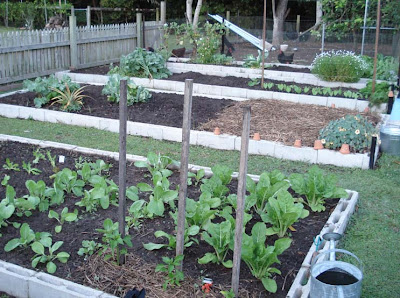Mmmmm, that flower was delicious! Flowers aren't just for the flower garden, there are quite a few flowers that can be eaten and when planted in the organic vegetable patch, add more than their beauty to your garden. We always have some kind of flowers growing alongside our vegetables. Sometimes they're flowers that can be added to a salad and eaten, like nasturtiums or chive flowers, some times they are planted to attract bees and other beneficial insects.
If you're growing flowering vegetables and fruit, most of them will need to be pollinated. This job is usually done by insects. You'll attract bees to your garden simply by having flowers for them to collect pollen from. They'll go from flower to flower pollinating your flowers as they move along the line.
The flowers that attract bees and beneficial bugs include pansies, alyssum, zinnias, calendulas, marigolds, yarrow, viburnum, daisies, gerberas, sunflowers, linarea, Queen Anne's lace, gypsophila, lobelia, cosmos and flowering herbs like coriander, borage, comfrey, dill, oregano, thyme, sage and chives.
If you're growing flowering vegetables and fruit, most of them will need to be pollinated. This job is usually done by insects. You'll attract bees to your garden simply by having flowers for them to collect pollen from. They'll go from flower to flower pollinating your flowers as they move along the line.
The flowers that attract bees and beneficial bugs include pansies, alyssum, zinnias, calendulas, marigolds, yarrow, viburnum, daisies, gerberas, sunflowers, linarea, Queen Anne's lace, gypsophila, lobelia, cosmos and flowering herbs like coriander, borage, comfrey, dill, oregano, thyme, sage and chives.
As in all things there are good and bad insects. You want to encourage ladybirds, hoverflies. lace wings and their offspring antlions, you don't want caterpillars, mealy bugs, thrips and aphids. If you encourage predatory insects and small lizards to your garden, they'll know to come back and when they do, they'll be looking for their favourite meal: the pests that eat your vegetables. To keep the beneficial predators around after they have eaten your garden pests, you'll have to supply a safe garden where they can find food and water most of the time. So plant the flowers they like, you'll be giving them plenty of nectar and pollen, and some water in the form of a bird bath or shallow bowl and you'll provide an insect-friendly habitat. When you add water for any sort of insect, bird or mammal, make sure it's not too deep for them. Most creatures like to sit on something while they drink, so pebbles in the water or on the edge give them a safe place to sit. Make sure you change the water frequently to avoid mosquitoes breeding in it.
Adopt a no spray policy. Any chemical pesticides will not only render your garden non-organic, they will kill both the good and the bed insects. Even the organic chilli and garlic sprays you make at home will kill most insects on contact.
Garden friendly insects will also need shelter. They usually find this in a biodiverse garden with all sorts of flowers and vegetables they can rest on and hide in. They love mulch and garden litter, so mulching your plants not only gives them the best chance of survival during hot weather, but it will also give small creatures a place to live.
Green Harvest - good bug mix. (Australia)
Grow Organic - good bug blend (California)
Good Bug Blend (Arizona)
General Advice on wildlife gardening (UK)
Edible flowers - (USA)
Edible flowers chart
Edible flowers - Isabell Shipard
A good Australian book - The Garden Guardians
I guess my favourite vegetable garden flowers are small daisies that grow into a small bush, yarrow, nasturtiums, and sunflowers. It's lovely to be able to pick the flowers you grow and bring them inside, but in this instance it's best to leave them in the garden, to provide food and shelter for those little beetles and bees you need in your vegie patch. So all you gardeners who are planting now, make sure you add a few flowers to your seasonal gardening plan. Just dot them throughout the garden so the insects have places to eat and hide in all your beds. It's another way of creating an organic and natural garden without having to spray or go on a bug chase.
Adopt a no spray policy. Any chemical pesticides will not only render your garden non-organic, they will kill both the good and the bed insects. Even the organic chilli and garlic sprays you make at home will kill most insects on contact.
Garden friendly insects will also need shelter. They usually find this in a biodiverse garden with all sorts of flowers and vegetables they can rest on and hide in. They love mulch and garden litter, so mulching your plants not only gives them the best chance of survival during hot weather, but it will also give small creatures a place to live.
Green Harvest - good bug mix. (Australia)
Grow Organic - good bug blend (California)
Good Bug Blend (Arizona)
General Advice on wildlife gardening (UK)
Edible flowers - (USA)
Edible flowers chart
Edible flowers - Isabell Shipard
A good Australian book - The Garden Guardians
I guess my favourite vegetable garden flowers are small daisies that grow into a small bush, yarrow, nasturtiums, and sunflowers. It's lovely to be able to pick the flowers you grow and bring them inside, but in this instance it's best to leave them in the garden, to provide food and shelter for those little beetles and bees you need in your vegie patch. So all you gardeners who are planting now, make sure you add a few flowers to your seasonal gardening plan. Just dot them throughout the garden so the insects have places to eat and hide in all your beds. It's another way of creating an organic and natural garden without having to spray or go on a bug chase.







